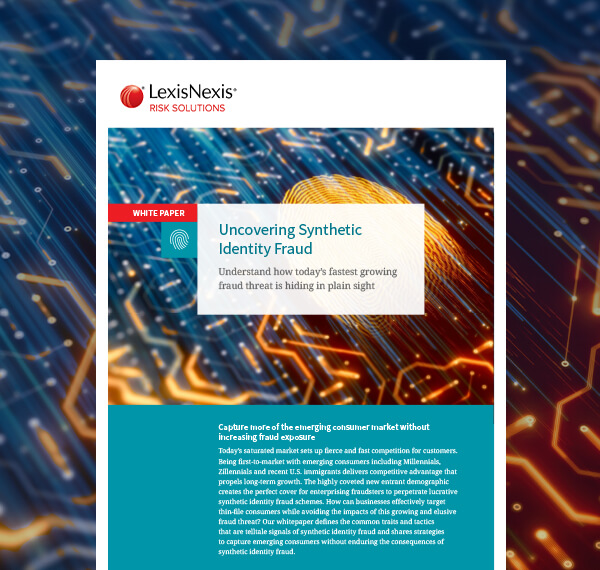
Synthetic Identity Fraud is a Complex and Growing Challenge
What is Synthetic Identity Fraud?

For example, the synthetic may have a real, “shippable” address and the SSN may appear valid, but the SSN, name, and date of birth combination do not match with any one person.
While this new approach was designed to provide higher safeguards for the public, it has also made it more difficult for fraud detection systems to identify a fictitious SSN. Compounding the problem is that synthetic identities are not created equally. The method fraudsters use to compose a fake identity has an impact on the level of financial harm a synthetic identity can do and how easily it can be detected.
The methods fraudsters use to create synthetic identities currently fall into two categories:
1. Manipulated Synthetics
2. Manufactured Synthetics
The Dangers of Synthetic Identity Fraud
The true danger of synthetic fraud is that, unlike third-party fraud where an entire identity is stolen and used to defraud enterprises and victims, synthetic fraud frequently has no specific consumer victim. That can sound like a good thing – until you realize that consumer victims are a critical tool in detecting and stopping fraud. The lack of a clear victim presents two challenges to enterprises.
- Without a consumer to alert an organization of fraudulent activity during account life, fraudsters can use synthetic identities to keep accounts open for months or years, garnering credit line increases and improved credit standing, only to eventually max out the credit line and disappear without a trace.
- Once the account charges off synthetic frauds are often categorized as credit bads – since there is no clear evidence of fraudulent activity. For enterprises, this makes it difficult to identify a synthetic fraud problem – and even harder to know if new defenses are proving effective.
These examples show the difficulty in tracking and quantifying losses from synthetic identities. Additionally, there are often inconsistencies within organizations on what constitutes a synthetic identity and even disagreement on whether this is a fraud or credit problem. Without a paper trail leading to a real person, the true victims of synthetic identity fraud are the lenders and service providers who are left to absorb what can be high-frequency and high-dollar losses.
Protecting Against Synthetic Identity Fraud
Synthetic identity fraud is a complex challenge that is growing by the day – solving it requires effective strategies that examine the core issue of identity legitimacy and the typical outcomes. By creating a holistic defense capable of addressing the entire issue, enterprises can better maintain performance as synthetic fraudsters shift their methodologies.
Combating synthetic fraud should not be done in a silo. Connect with other industry partners and law enforcement to share information, identify trends, behaviors, and threats. By leveraging these best practices, you can help improve your ability to detect and mitigate synthetic identity fraud.
Contact us to learn more about how to stay ahead of evolving threats with advanced fraud detection technology – while reducing costs and increasing efficiency. Begin by downloading the white paper, “Uncovering Synthetic Identity Fraud".
Complete the form to download
This article is for educational purposes only and does not guarantee the functionality or features of LexisNexis products identified. LexisNexis does not warrant this article is complete or error-free.
